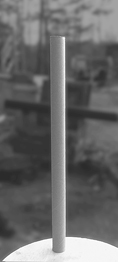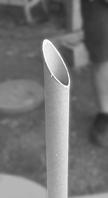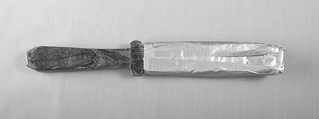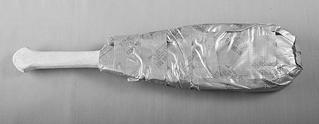Read Hank Reinhardt's Book of Knives: A Practical and Illustrated Guide to Knife Fighting Online
Authors: Hank Reinhardt
Hank Reinhardt's Book of Knives: A Practical and Illustrated Guide to Knife Fighting (14 page)

I’ve also tested a laminated blade from Cold Steel in their Natchez Bowie style. This uses a combination of two stainless steels forged together in a sandwich. The edge-holding ability was excellent right out of the box. With a helper feeding me rope, I cut a hundred pieces of manila rope at a speed so fast it was a miracle I did not start a fire in my backyard.
Ladies and gents, if we continue with these new tempering techniques and laminated steels, we may very easily see a knife offered from a factory that will cut a thousand pieces of one-inch manila rope, and when placed in a vise will take a 90-degree bend and return to true.
So keep in mind, when we talk about blade steels—don’t be hung up on what type of steel is used in the knife. Just stick with the performance.
8
ACQUIRING BASIC SKILLS
You’ve chosen a pocket knife. You know the edge is sharp. Now we need to warm up. Take your knife in your master hand (right or left) and begin to slowly open the knife. The reason I say “slowly” is because even with our newer designs, trying to master this skill too quickly will earn you cut fingers and wounded pride. So take your knife and slowly open it. Then put the knife in your left hand and begin to open it with your left hand and pass it back to your right. Take your time. If you continue to practice this routine soon you can open your knife as fast with either hand. It is very important to be able to use both hands, so if your master hand is injured you will not be put out of action.
So, step one, open the knife right-handed, pass it over to your left and open it left-handed. Pass it back to your right hand and continue this swapping until you are proficient with both hands.
PRACTICING THE CUT
Now it’s time to practice some cutting. A good practice target is a cardboard tube that comes with paper towel rolls. Stand the tube on a flat surface and practice cutting it in two with one fast slice. You must be cautious here. Make sure all your body parts—feet, hands, and knees—are out of the way. Cut at a 45-degree angle, which will pin the roll for a second and will allow you to cut the tube in half. It is possible to be fast enough to cut the tube in half and still leave the bottom part standing. This is tricky. I have been able to do this about once in thirty tries. But the more you practice the easier it gets.


Cutting a tube; before and after.
Photo by Casey Ferguson.
After you can sever the tube with your right hand, it is time to start practicing with your left. Keep working your lesser hand until it is as proficient as the master hand, then it’s time to start practicing drawing the knife from your pocket. Once again, start out slowly. Don’t try for speed at first. Make sure your draw is fumble free. Once you master the smooth draw and smooth opening, it’s time to start practicing drawing the knife from your pocket and cutting the cardboard tube in one motion. Keep in mind that yanking the knife out too fast, and then having it go sailing through the air, creates a loss of much face. So keep it slow and keep it simple until you’ve mastered the technique.
The next cut you practice will insure blade alignment and speed. Get a large package of notebook paper. Take one sheet of the paper and fold it over to make a pyramid. Stand the pyramid on a table or counter about waist high and practice cutting it in half. Not only is this difficult to do, but it is very difficult to get the paper to stand on its own. If there is an air conditioner or heater going, or someone moving in the room, the paper is easily blown over. This trick requires an extremely sharp knife and a lot of speed. The angle of the knife must be just right. It is possible to cut the two pieces of paper in half and not have the bottom portion fall over. I’ve only been able to do this about twice in a thousand tries.
Now it’s time to test both strength and speed. Find some half-inch manila or sisal rope. Hang it off a limb or swing set in your yard and practice making three very fast cuts. First slash at the right hand side of the rope. Then, cutting from left to right, make three more very fast cuts as well. Practice this until you get even, fast cuts on the rope. But don’t forget safety. Remember you are swinging viciously with a very sharp instrument. Keep your hands, knees, and legs well out of the way.


Cutting a rope; before & after.
Photo by Casey Ferguson.
PRACTICING WITH THE POINT
Now that you’ve mastered speed cutting with the edge, it is time to consider that the pocket knife has a point as well as an edge. Take a plastic soft drink bottle and fill it with water. Place it at about chest level and try to make three quick thrusts before it falls over. Don’t just try to stab wildly at the bottle. Put a mark or a one-inch-square piece of tape on it and aim for that spot. Practice drawing the knife out of your pocket and stabbing at the spot. Continue to practice until you hit the spot. Once you can hit it (or close to it), try to increase your speed. Keep the same tempo as you did with the manila rope. This is also true when we cut the rope. Plastic bottles are easy to find, cardboard tubes come with paper towel rolls, and manila rope can be bought at hardware stores. They are good, cheap practice materials that can die many times for your improvement.
Now that we have gotten to the point that you can draw your knife and smoothly stab an object, let’s talk a little bit about footwork. Alleys are full of junk. They are dark, bumpy, and slippery. Your own backyard is also. You can’t count on your knife fight occurring in a perfectly maintained gymnasium. So be aware of your surroundings. The best way to avoid tripping over junk in the road is to retreat by taking a step back, then pulling your other foot back to you. It is also the best way to travel, when moving either left or right, to keep from getting tangled in your own feet.
Practice these moves: step backwards until you run into a wall, then step forward and left. Step backwards until you run into the wall again, then step forward and to your right. This is awkward at first, but once you get the feel of your own feet it becomes second nature. But I emphasize again doing it slowly until second nature kicks in.
Next, go outside and practice your newly acquired footwork. Take along some bottles, paper, and a bag of garbage. That way you will get the feel of junk on the ground. It is very important you learn how to remain standing in difficult terrain. A smart opponent will try to maneuver you into cracks on the ground or into garbage. I suggest you do this to them before they do it to you. If you can maneuver yourself until your opponent falls, it is much to your advantage.
I once saw Hank do this very thing in a practice fight where the area featured some bushes and a creek behind his opponent. He maneuvered the individual to the edge of the bushes where he made a fast hard lunge, at which point the opponent stepped back out of the way. We heard a large scream and the opponent ended up waist-deep in water and covered in mud. When we went down to the creek to help him up, he looked up at Hank and said, “If I didn’t know better I’d think you did that on purpose.”
Hank looked up at me sternly and said, “Greg, what do you think about that?”
I looked back at Hank and said, “One of the first things you ever told me is that there are no rules in a fight.”
These are wise words to remember. When knives come out, play time is over. Keep this in mind: you do whatever you have to do to win.
SPARRING
There are several companies that make suitable knives for sparring.

A rubber Fairbairn-Sykes.
You can pick one of these or you can make your own. One of the simplest and cheapest simulated knives is a rolled-up newspaper. Remember this has to duplicate the length of your pocket knife. So measure your knife and make sure your newspaper is no longer. Just roll the paper tight, but not too tight, with just a little bend to it. Make it roughly about an inch-and-a-half in diameter, and bind it with three strips of tape. Duct tape or masking tape work well.

Sparring knife Hank weighted with tape and lead weight to give it the heft of a real knife.
Photo by Casey Ferguson. HRC630



Top to bottom: a sparring Bowie, a sparring knife with wooden handle for dagger, and a sparring kukri.
